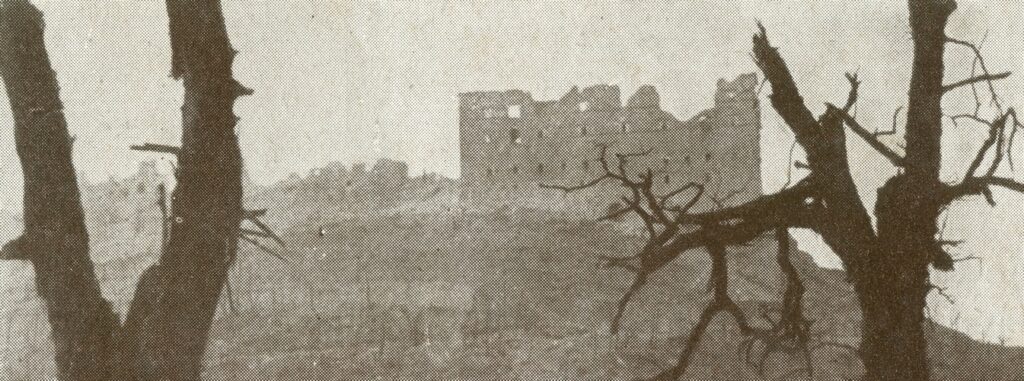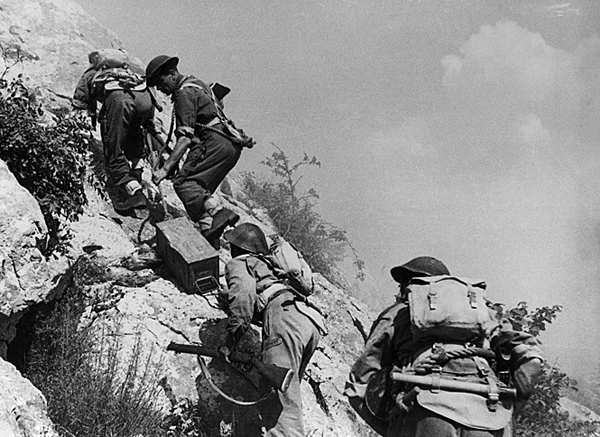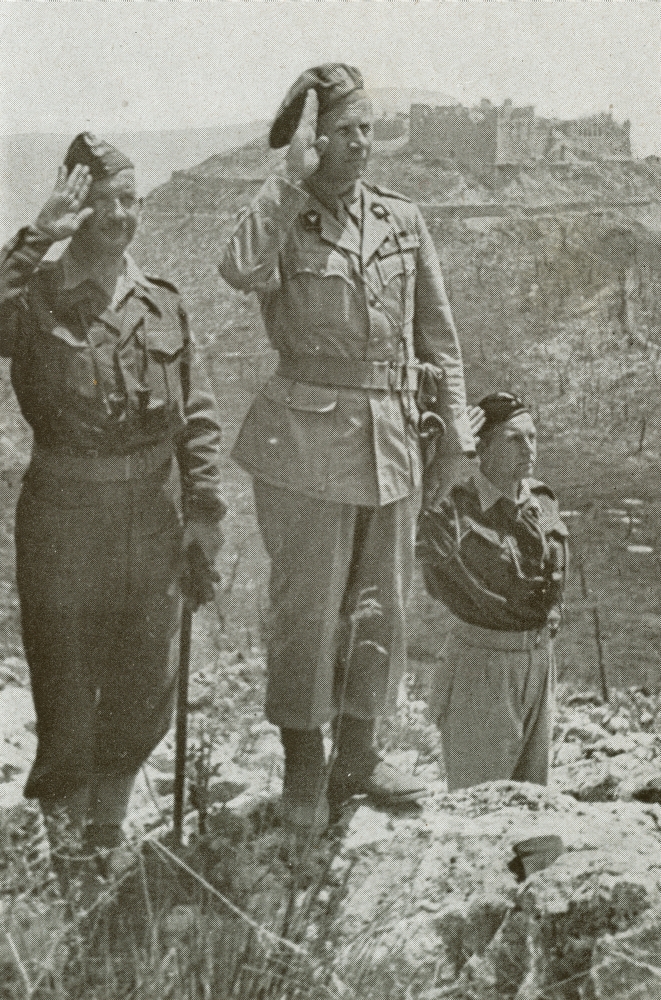Monte Cassino

Eighty years ago today, 18 May 1944, at 10.20am, the Polish flag flew over the ruins of the Benedictine monastery on top of Monte Cassino.
The ruins had loomed over the soldiers of the Second Polish Corps in Italy, led by Lieutenant-General Władysław Anders, since they entered the fray surrounding Monte Cassino—the main stronghold of the German’s Gustav Line—on 3 March.
The crack German units, considered by German headquarters as of the “highest fighting value by virtue of their morale and special training” had defended their position since 20 January. The mountain completely dominated the surrounding hills and valleys, and allowed the Germans to thwart any Allied attempt at breaking through to Rome.
The first Allied units to take on the Germans at Monte Cassino were two American corps, and one French. New Zealand divisions replaced them when they withdrew, exhausted.
A second push in mid-February by the 2nd New Zealand and 4th Indian divisions, too, proved futile, and included the Allies’ bombing the monastery on the assumption that the Germans had been using the buildings: They had not, but their ruins provided even better cover than they already had. At this stage, the British Eighth Army took over from the American Fifth.
Anders addressed his “50,000 strong” soldiers via the radio on the eve of 3 March and reminded them of what they had been through in the “prisons and concentration camps” of the USSR. “We went through wild and deserted spaces and were decimated by frost, epidemics and our enemies,” he told his men. “We now follow the ancient road of the Dombrowski legions,” he said, referring to the Polish soldiers who fought in Italy from 1795, under the Polish general whose name became part of the chorus of a military song that became the Polish national anthem in 1927.
The Poles in 1944 joined the battle from positions on the east of the mountain, but started quietly, mainly in a communications role. Polish units went to the front line in the order that their transports arrived.
That third push for Monte Cassino fizzled out, and a few days before 23 March, General Leese visited General Anders at his headquarters in Vinchiarturo and informed him that the Germans’ “continual repelling” of their attacks on Monte Cassino had placed the Allied troops elsewhere in a “difficult position.” Leese had received the order for the British Eighth to break through the Gustav and Hitler lines, and gave that task to the Second Polish Corps, which had become a component of the British Eighth on 30 January 1944.
Anders, in his book An Army in Exile: “General Leese made it clear that he understood all that was involved. The stubbornness of the German defence at Cassino and on Monastery Hill was already a byword, for although the Monastery had been bombed, and the town of Cassino was a heap of ruins, the Germans still held firm and blocked the road to Rome.
“It was therefore clear that Monte Cassino, upon which the blood of five gallant nations—Americans, British, French, New Zealand and Indians—had already been shed, must be captured in spite of the German boast that it was impregnable.”
Polish headquarters moved to Monte Cassino, and had its own view of the monastery ruins. On 7 April, with General Anders reconnoitred the area, visited and received “much useful advice” from New Zealand General Bernard Freyberg and British General Charles Keightley, and started to lay out detailed plans, which included the need to:
– Build up huge stocks of ammunition and equipment, made difficult because the only two mountain tracks that could be used were under German observation and fire for 10 kilometres. The supply route could only be used at night, without lights; supplies often had to be carried in the last stages, by soldiers under fire.
– Organise a system of control posts connected by telephone.
– Reinforce and widen the tracks and roads for “all kinds of vehicles, including tanks.”
– Work under cover of smokescreens, to employ “every possible trick of camouflage” to hide artillery positions, supplies, and traffic.
– Hold practice sessions in fighting, mountain climbing, and for some squadrons, flame throwing.
By 6 May, all Polish commanding officers down to battalion commanders knew every detail of the coming operation, and its place within the Allied plan of attack.
A few days before D-day for the whole front, Polish soldiers waited in their positions on the mountain. They hid “under conditions of great hardship” in primitive shelters made from corrugated iron sheets, and large boulders, and under the Germans’ constant searching fire.
Nightfall of 11 May saw the beginning of the fourth and final battle for Monte Cassino.

_______________
The preparations were intense, but the battle conditions were far worse: The night and the smoke prevented the soldiers from seeing more than a few steps ahead; soldiers who had to frequently dive for cover lost contact with one another; the German projectiles came from all directions, including caves where they had stored their own supplies; the terrain prevented the artillery from helping the infantry.
As one officer died, his place was taken by the next in seniority. By 13 May, the Poles had withdrawn. Anders concluded that his men would be unable to “silence the enemy batteries” in positions on either side of the mountain slopes.
On 16 May, General Leese ordered that the British and the Poles co-ordinate to prevent the latter from fighting an “isolated battle.”
The second attack from the Poles was to start the next day, with “fresh battalions” but within the generally unchanged plan. Every Polish soldier available, was used.
Anders estimated that: “The enemy must be quite as exhausted as we were, or even more so, and that in the next day’s fighting… our attack, even if less powerful than our first effort, would achieve a definite success.”
He was proved right: on the morning of 18 May 1944, when the 3rd Carpathian Division renewed their attacks on the monastery, they discovered that the Germans had withdrawn most of its men.
Monte Cassino had been won by the Poles, who could not have been expecting such a quick victory, because the only Polish flag on hand was that of a patrol of the 12th Polish lancers, which flew until an official Polish flag was found.
An hour later, General Leese congratulated General Anders, who ordered the Union flag be hoisted next to the Polish one.
Anders’ description of the aftermath:
“The battlefield presented a dreary sight. There were enormous dumps of unused ammunition and here and there heaps of land mines. Corpses of Polish and German soldiers, sometimes entangled in a deathly embrace, lay everywhere, and the air was full of the stench of rotting bodies. There were overturned tanks with broken caterpillars and others standing as if ready for an attack, with their guns still pointing towards the monastery. The slopes of the hills, particularly where the fire had been less intense, were covered with poppies in incredible number, their red flowers weirdly appropriate to the scene. All that was left of the oak grove of the so-called Valley of Death were splintered tree stumps. Crater after crater pitted the sides of the hills, and scattered over them were fragments of uniforms and tin helmets, Tommy guns, Spandaus, Schmeissers and hand-grenades.
“Of the monastery itself there remained only an enormous heap of ruins and rubble, with here and there some broken columns. Only the western wall, over which the two flags flew, was still standing. A cracked church bell lay on the ground next to an unexploded shell of the heaviest calibre, and on shattered walls and ceilings fragments of paintings and frescoes could be seen. Priceless works of art, sculpture and books lay in the dust and broken plaster.”

The red poppies that kept blooming among the blood of the dead deeply affected the survivors. A few hours before the Poles captured Monte Cassino, one of the soldiers, poet and singer Feliks Konarski wrote the song Czerwone Maki na Monte Cassino (Red Poppies on Monte Cassino) about those poppies, and that blood. Another soldier, composer and conductor Alfred Schütz, wrote the melody.
On 18 May, 80 years ago, at the base of the mountain, the men of the Second Polish Army Corps cried as they sang the first two stanzas of Konarski’s song, its words apparently painted on a huge cardboard banner for the soldiers to follow.
My paternal grandfather survived Monte Cassino. Aged 47, he was in one of the supply units. I bought General Anders’ book in the hope of finding out more about what he had gone through, and I was grateful a few years later for the opportunity to interview Monte Cassino veterans, the late Władysław Błażków, Władysław Piotrkowski, Bronisław Bojanowski, and Adam Piotrzkiewicz, who talked about what it was like on the Italian battlefields.
The Polish Monte Cassino battles did not stop on 18 May 1944. The neighbouring hill, known as 575, was only “cleared of the enemy” the next day. Polish units then advanced to the Hitler line, on Piedimonte, and finally cleared the road to Rome on 25 May 1944.
The II Polish Army Corps’ casualty count after the Monte Cassino and Piedimonte battles:
Killed: 72 officers and 788 other ranks
Wounded: 204 officers and 2,618 other ranks
Missing: 5 officers and 97 other ranks
Total killed or missing in action: 962
Total wounded: 2,822.
—Basia Scrivens
18 May 2024
_______________
Photographs courtesy the late Władysław Błażków, who loaned me his 3rd Carpathian Rifle Division photograph album. The last is General Bolesław Duch saluting the battle’s dead.
Lieutenant-General Anders’ book, An Army in Exile; The Story of the Second Polish Corps, was originally published in 1949 and reprinted by The Battery Press, Tennessee, USA, in 2004, ISBN: 0-809839-043-5.
For more details on the 1944 military timeline, go to https://polishhistorynewzealand.org/1944-2/
See Władysław Błażków’s story at https://polishhistorynewzealand.org/wladyslaw-blazkow-2/
See Władysław Piotrkowski’s story at https://polishhistorynewzealand.org/wladyslaw-piotrkowski/
See Bronisław Bojanowski’s story at https://polishhistorynewzealand.org/bronislaw-bojanowski/
See Adam Piotrzkiewicz’s story at https://polishhistorynewzealand.org/adam-piotrzkiewicz/
If you would like to comment on this post, or any other story, please email editor@polishhistorynewzealand.org/
